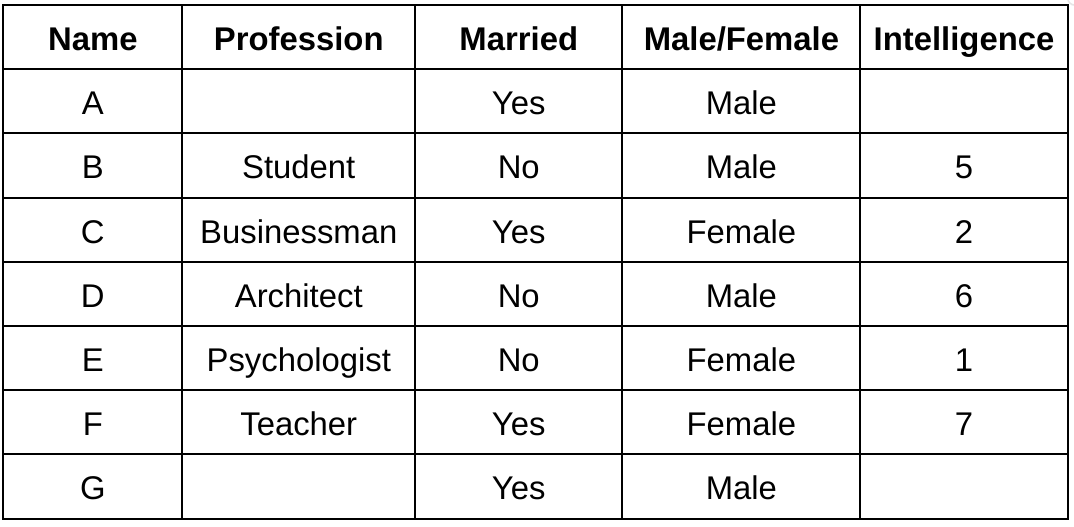SRCC GBO 2017 Question Paper
Read the following information to answer these questions.
(i) There is a group of seven persons A, B, C, D, E, F and G.
(ii) There are four males, three females, two married couples and three unmarried persons in the group.
(iii) The seven persons are seated in a row on the bench.
(iv) Their professions are engineer, teacher, doctor, psychologist, businessman, architect and student.
(v) B is not married and another person, the psychologist, is the most intelligent.
(vi) The engineer is married to the teacher, who is the least intelligent of the group.
(vii) D is an architect. He is sitting on the leftmost corner.
(viii) The student is sitting on the rightmost corner of the bench.
(ix) The doctor is married to C. C is the second most intelligent of the group followed by her husband.
(x) The least intelligent of the group is Sitting on the immediate right of D, followed by the most intelligent.
(xi) There are as many more intelligent persons than the engineer as there are less intelligent.
(xii) On the bench followed by D, there are three females sitting in succession.
(xiii) The psychologistis a female.
(xiv) The student is more intelligent than the architect, who is more intelligent than only one person, F.
(xv) Neither A nor G is a female.
SRCC GBO 2017 - Question 114
Which of these represents the correct order of intelligence(in the decreasing sequence)?
Each of these questions has an assertion (A) and a reason (R). Mark answer as
SRCC GBO 2017 - Question 115
Assertion (A): There was no country known as ‘Bangladesh’ when India was partitioned in 1947.
Reason (R): ‘Bangladesh’ was a part of Pakistan at the time of partition of India in 1947.
SRCC GBO 2017 - Question 116
Assertion (A) : India should adopt presidential type of government.
Reason (R) : Yes, it will bring political order in the country.
SRCC GBO 2017 - Question 117
Assertion(A): States of India should be giventTyore autonomy/freedom.
Reason (R) : No, because it will encourage separatist tendencies.
SRCC GBO 2017 - Question 118
Assertion (A): Indian National Flag is known as tricolor.
Reason (R): Indian National Flag has three colours.
Each of the following questions is based on a set of propositions I-IV. Select the best answer to each question.
I. All Ps are Q.
II. Some Ps are not Q.
III. Some, but not all, Ps are Q.
IV. No Ps are Q.
SRCC GBO 2017 - Question 119
Considered only by themselves, which of the following pairs of statements might either both be true or both be false ?
SRCC GBO 2017 - Question 120
Considered only by themselves, all of the followind pairs of statements might both be false but could not both be true except



